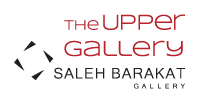EXHIBITIONS
Saleh Barakat Gallery presents False Witnesses, a solo show by the influential Iraqi artist Dia al-Azzawi (b. 1939), whose iconic work is inspired by the long and shared history of the Arab world, from ancient Mesopotamia to the present day. Originally scheduled for October 2023, then rescheduled for September 2024, this exhibition is a biting critique of the corruption endemic to all political systems, seen through the prism of recent events in Iraq. Although the main body of works directly reference the October Revolution (2019–20), the destruction of Mosul (2014–17) and Aleppo (2012–16), and the sectarian divisions in Baghdad (2003 onwards), they are part of Azzawi's ongoing endeavour to highlight injustice in general and champion the voices of all victims of oppression through his work. The artist has also added a display of charcoal drawings from the celebrated series Night of Extermination (2023), which were made at the start of the genocide in Gaza, and his new daftar (artist’s book) called Gaza: The Pain that Opened My Daughter’s Eyes (2025), to emphasise the fact that the violent oppression of Palestinians is tantamount to injustice against us all.
In October 2023, during the first weeks of the genocide in Gaza, Dia al-Azzawi made a series of twelve charcoal drawings called Nights of Extermination. In these works, centred on the eyes of the victims, aerial aggressions take the form of vicious birds of prey, billowing smoke and unknown objects raining from the skies, while scattered body parts are heaped in the confusion of widespread casualty and death. The innocent victims stare directly out of Azzawi’s drawings in obvious distress, entreating the viewer’s sympathy at the unfairness and hopelessness of their desperate fate.
In a 2025 daftar (or artist’s book) called Gaza: the Pain that Opened My Daughter’s Eyes, Azzawi overlays faces of innocent victims in black and white with red paint to represent both their suffering and the secondary agony of witnessing atrocities through journalism and social media, an experience of painful awakening that he observed in his own daughter, which is further signified by artist’s own handprint of testimony (also in red paint).
These recent works about Gaza can be viewed as a continuation of Azzawi’s ongoing series Land of Darkness (1991–present), which began with a set of charcoal drawings about Iraqi civilians and a diarised daftar called Book of Darkness, during the 1991 Gulf War. At the same time, they are also part of Azzawi’s continued efforts to highlight injustice against Palestinians, which can be seen in his work from the early 1970s onwards, as a symbol for the unfairness of global inequality and all corrupt political systems: this criticism is at the heart of the works displayed in the solo exhibition ‘False Witnesses’.

constant
all that is movement
There is a gentle contradiction that flows through the work of Lebanese painter and poet Afaf Zurayk, a constancy and yet continual movement that grows and flourishes in the complex folds and spaces of her paintings and her words.
White canvas holds, a line moving with and against, a sparse, caring motion. There is an endlessness to the spaces that Zurayk deftly shapes, a glimmer of emergence, then disappearance, re-emergence, a quiet skimming of the surface of form, experience and emotion, then again submergence, coming up again as if for air, breath. This is how a life might be described, all of life.
While this work enters with such lightness, as if alighting at the very corner of thought, yet if confronted, or perhaps just looked at squarely, the experience deepens, continues, gives more, does not disappear in the moment, recedes only to return.
This doubling, the glimpse and the continuation, the constant and enduring, the light and ephemeral.
To know the way to depth from light and back again.
The subtle and mutable line
the material life.
In the words of Zurayk,
containing the darkness and contained by it.Afaf Zurayk is a Lebanese American artist, writer and educator.
Afaf Zurayk is a Lebanese American artist, writer and educator. Her artistic and writing practices seek transparency in depicting the color of light, guiding the audience through turbulence towards acceptance. Zurayk graduated with a B.A. in Fine Arts (with distinction) from the American University of Beirut in 1970 and earned an M.A. in Fine Arts from Harvard University.
Zurayk has exhibited her art extensively and has been reviewed in The Washington Post, the Washington Review, Al-Hayat and L’Orient–Le Jour among other publications. Her art is in the collections of the British Museum, London, UK; Barjeel Art Foundation, Sharjah, UAE; the Sursock Museum, Beirut, Lebanon; and Darat al - Funun, Amman, Jordan. She is represented by Saleh Barakat Gallery in Beirut, Lebanon.

